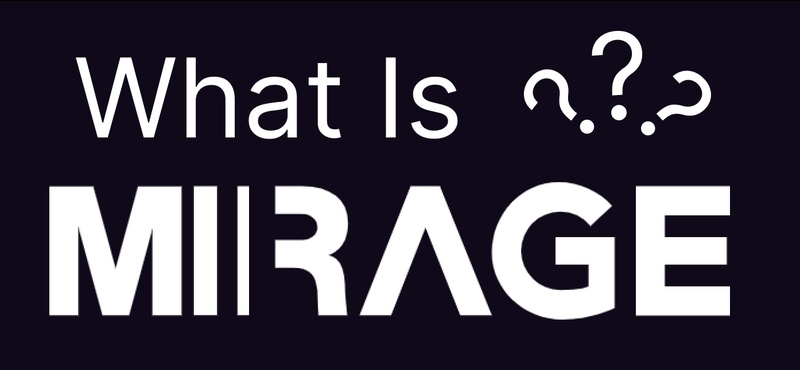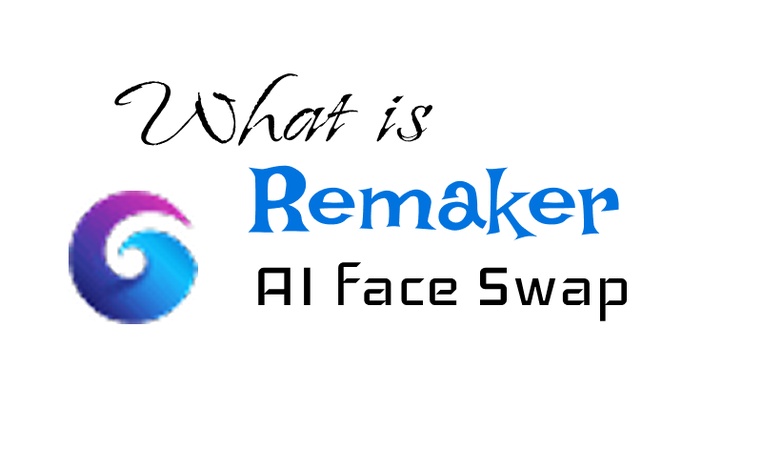Bland AI TTS aims to generate highly realistic voices that are virtually indistinguishable from human speech, mimicking tone, cadence, emotion, and pronunciation with impressive accuracy. It represents a significant leap forward in realistic voice AI, offering powerful features for voice cloning, emotional intelligence, and context learning. We will review bland ai tts.
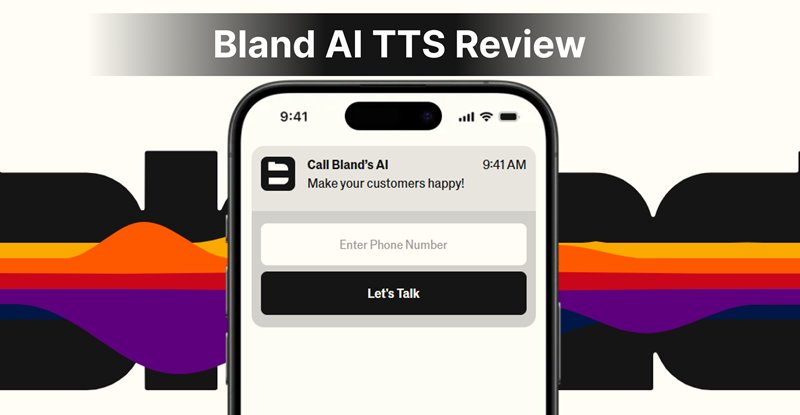
Part 1: What Is Bland AI TTS
Bland AI TTS is a text-to-speech (TTS) engine developed by the AI startup Bland AI, which they claim is the first to cross the uncanny valley of voice AI. This means it aims to generate highly realistic, human-like voices that are difficult to distinguish from actual human speech.
Bland AI Overview
Bland AI is a San Francisco-based AI startup, founded in 2023 by Sobhan Nejad, that specializes in AI phone calling solutions and conversational AI for enterprises. Their core offering revolves around creating highly realistic, human-like AI phone agents capable of handling complex interactions at scale.
Bland AI Languages
Bland AI emphasizes its multilingual capabilities, stating that its AI phone agents speak any language. This is a significant advantage for businesses operating globally. Here's a breakdown of what it means for Bland AI:
- Broad Language Support: Bland AI's platform is designed to handle calls in various languages. While specific comprehensive lists aren't always publicly detailed, their marketing often states "speak any language" and mentions key global languages.
- Multilingual Adaptation: The underlying model architecture is built for rapid adaptation to new languages. This means they can quickly train their models to understand and generate speech in a new language with relatively small amounts of data, while maintaining natural prosody (the rhythm, stress, and intonation of speech).
- For Enterprise Clients: It's often highlighted that "foreign languages & transcription support for enterprise clients" is a key offering. This suggests that while there might be a baseline of common languages, more specialized or less common languages might be part of custom enterprise solutions.
- AI Babel Technology: Bland AI has discussed its "Bland Babel" technology, which is designed for low-latency, noise-robust transcription. This system employs advanced techniques like statistical confidence across multiple language models and pronunciation modeling to accurately identify and handle different languages, even in situations like "code-switching" (where someone switches between languages within the same sentence).
Bland AI Enterprise
Bland AI offers a comprehensive suite of solutions tailored specifically for enterprise-level businesses that need to automate high-volume, complex phone interactions. Their focus is on providing a robust, scalable, and secure infrastructure for deploying highly realistic AI phone agents.
How Many Bland AI Languages in TTS
Bland AI's approach to languages in its TTS is a bit nuanced, particularly between its standard offerings and enterprise solutions. While Bland AI's marketing often states that its AI phone agents "speak any language," the reality for their core TTS service tends to be:
- Primarily English by Default: For standard plans and out-of-the-box usage, Bland AI's primary supported language is English.
- Extensive Multilingual Support for Enterprise Clients: The "speak any language" claim becomes more fully realized with their enterprise offerings. For enterprise clients, Bland AI provides:
- Foreign languages & transcription support: This means they can handle both generating speech in various languages and accurately transcribing calls in those languages.
- Custom models: Enterprise clients can have custom AI models fine-tuned for specific languages and dialects.
- Rapid adaptation: Their underlying technology ("Bland Babel") is designed to adapt quickly to new languages with relatively small data sets, maintaining natural prosody.
Bland AI TTS Pricing and Plans
Bland AI's pricing and plans are structured to cater to a range of users, from those just starting out to large enterprises with high-volume needs. It's important to note that while they offer some tiered plans, their core pricing is heavily usage-based, and advanced features often come with additional costs. Here's a table summarizing Bland AI's TTS pricing and plans:
| Plan | Price | Features |
|---|---|---|
| Start | Free | Up to 100 calls/day, 10 concurrent calls, 1 voice clone, basic TTS features |
| Scale | $499/month | 2,000 calls/day, 50 concurrent calls, 5 voice clones, API access |
| Enterprise | Custom Pricing | Unlimited usage, dedicated infrastructure, custom AI models, premium support |
| Standard Usage | $0.09/min (active call time) | Pay-as-you-go model for voice interactions |
| SMS Add-on | 0.02/message | Inbound and outbound SMS billing |
Part 2: Key Features of Bland AI TTS
Bland AI's Text-to-Speech (TTS) engine, known as Bland TTS, is a cornerstone of their AI phone calling platform. It's designed to make AI-generated speech virtually indistinguishable from human conversation. Here are its key features:
- Crossing the Uncanny Valley Realism: This is Bland AI's primary claim. Their TTS aims to produce voices that are not just understandable, but genuinely human-like, mimicking subtle nuances of tone, cadence, rhythm, and pronunciation. This makes interactions feel natural and less robotic.
- One-Shot Voice Cloning: A significant differentiator. Bland TTS can clone any human voice from a single, short MP3 audio clip. This drastically reduces the effort and data traditionally required for custom voice generation, making personalization highly accessible.
- Style Transfer and "Mashups": Beyond simple cloning, the technology can perform "one-shot style transfer." This allows users to apply the unique speaking style (e.g., intonation, rhythm) from one voice to another, or even combine stylistic elements from multiple voices to create entirely new, customized vocal personas.
- Context Learning and Emotional Intelligence: Leveraging large language models (LLMs), Bland TTS is designed to understand the semantic meaning and context of the input text. This enables it to generate speech with appropriate emotional tones (e.g., excited, calm, serious, empathetic), making the AI's responses more natural and contextually relevant.
- Sound Effect Generation: Uniquely, Bland TTS can also generate non-verbal sounds like laughter, sighs, or other environmental sounds. This further enhances the realism and immersion of the generated audio, particularly useful for applications like gaming, film dubbing, or virtual reality.
- Sub-Second Latency: Bland AI emphasizes its self-hosted, end-to-end infrastructure which allows for extremely fast response times, often quoted as sub-second latency. This is crucial for natural, real-time conversational AI, as it prevents awkward pauses and delays that can break immersion.
- Multilingual Adaptation: While English is a primary focus, Bland AI's underlying model architecture is built for efficient adaptation to new languages. For enterprise clients, this means their AI agents can "speak any language" with natural prosody, requiring relatively small amounts of target-language data for effective implementation.
- Developer-Friendly API: Bland TTS is primarily accessed via a robust API, allowing developers to integrate its advanced voice capabilities into their custom applications with a relatively small amount of code. This facilitates building AI-powered helplines, virtual assistants, content creation tools, and more.
- Integration Capabilities: The TTS, as part of Bland AI's larger platform, can be seamlessly integrated with other business systems like CRMs, ERPs, and schedulers. This means the AI agents powered by Bland TTS can not only speak naturally but also take real-time actions during a call (e.g., update a customer record, book an appointment).
Part 3: Bland AI TTS vs. Alternatives
Bland AI TTS is a specialized and highly performant text-to-speech solution, particularly when integrated into their full AI phone agent platform. To understand its position, it's crucial to compare it against different types of alternatives: general-purpose TTS providers, and other conversational AI platforms.
Comparision of Bland AI TTS vs. Alternatives
Here's a comparison of Bland AI TTS, Chatterbox TTS and Balabolka, focusing on their features, pricing, and ideal use cases:
| Tool | Core Functions | Unique Features | Pricing | Best For |
|---|---|---|---|---|
| Bland AI TTS | Real-time voice synthesis | API-first design, voice cloning (beta), GPT prompt support, SOC 2 & HIPAA compliant | 0.09/min outbound, $0.04/min inbound, $15/month number rental | AI phone agents, enterprise voice automation, developer integrations |
| Chatterbox TTS | Open-source expressive TTS | Emotion exaggeration control, zero-shot voice cloning, sub-200ms latency, watermarking | Free (MIT license) | Game dialogue, AI agents, creative narration, research & experimentation |
| Balabolka | Offline text-to-speech | Supports multiple file formats, customizable pronunciation, batch processing | Free (Standard), ~$100 for commercial license | Accessibility, language learners, offline reading, personal TTS use |
Brief Overview of Bland AI TTS Alternatives
HitPaw Edimakor: Is an AI-powered video editing platform designed for creators, educators, and marketers. It offers: AI avatars and voice cloning, Auto-subtitling and speech-to-text, Image-to-video animation, Background removal and voice changer and a vast stock media library from GIPHY, Unsplash, and Pixabay.
Key Features of Edimakor's TTS:
- Realistic AI-Generated Voices: Edimakor claims to provide "lifelike AI-generated voices" that sound natural and realistic. It aims to reduce the need for microphones, voice actors, or custom recordings.
- Extensive Voice Library: It offers a library of 400+ AI voices (both male and female) with various tones and styles.
- Multi-Language Support: Edimakor's TTS supports over 50 languages, including major ones like English (US & UK), Spanish, French, German, Portuguese, Arabic, Korean, Chinese, Japanese, Turkish, Indonesian, and various regional dialects. It also supports 120+ languages for transcription and translation features.
- Emotional Voice Styles: A notable feature is the inclusion of 12 unique voice styles to convey different emotions. This allows users to match the narration's tone to the video's content (e.g., daily vlogs, explanations, tutorials, promotions). Examples of emotional tones include Angry, Chatting, Delighted, Excited, Friendly, Hopeful, Sad, Shouting, and Fearful.
- Adjustable Voice Parameters: Users can typically adjust the volume, speed, and pitch of the generated voice to fine-tune the output.
- Integrated Workflow: The TTS feature is directly integrated into the video editing timeline. Users can add text to their video and then convert it to speech directly within the editor to create instant voiceovers.
- AI Script Generator Integration: You can use Edimakor's AI script generator to create text, and then seamlessly convert that script into a voiceover using the TTS feature.
- Export Options: Generated speech can be saved as audio files for later use, or directly incorporated into the video for export.
Part 4: How to Use Bland AI TTS
Bland AI's TTS (Text-to-Speech) is not a standalone product you simply "use" to convert text files into audio. Instead, it's an integral component of their AI phone calling platform. Therefore, using Bland AI TTS means building and deploying an AI phone agent that utilizes their advanced TTS engine for highly realistic spoken interactions.
Bland AI TTS Use Cases and Applications
Bland AI envisions its TTS technology revolutionizing various industries:
- Intelligent Customer Service: Creating lifelike and natural voices for AI-powered customer support, leading to more engaging interactions.
- Content Creation: Providing efficient and personalized solutions for podcasts, audiobooks, and video dubbing.
- Virtual Assistants: Developing more human-like AI assistants with multi-style voice interactions.
- Education and Entertainment: Enhancing immersion in educational content and games through sound effects and emotional voices.
- Automated Phone Calls: Bland AI also offers AI phone agents that can handle sales, scheduling, and customer support, capable of speaking any language and working 24/7.
Potential use cases for Bland AI TTS includes:
- Podcasting
- Audiobook narration
- Virtual assistants (beyond phone calls)
- Content localization & dubbing etc.
Tutorial of Bland AI TTS
Here are steps to use Bland AI TTS (via their API):
- Go to the Bland AI website (bland.ai) and sign up for an account. They offer a free "Start" plan with limited call minutes to test.
- Once logged in, navigate to the "API Access" or "Settings" section of your dashboard.
- Generate a new API key and keep it secure. This key authenticates your requests to their API.
- Design your conversation flow (prompt engineering & papathway). Choose your voice. Bland AI offers a library of human-like voices you can select from.
- Make API calls to initiate calls.

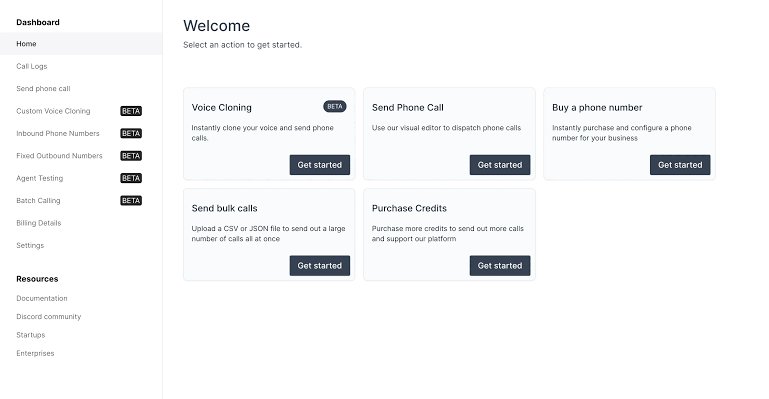
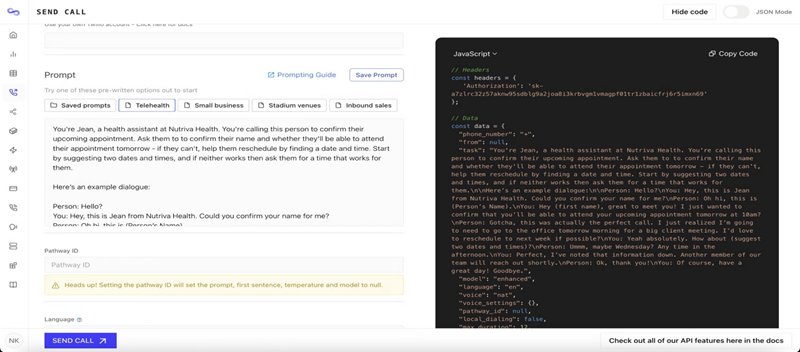

Part 5: Bland AI TTS Reviews and Ratings
While Bland AI's technology has been lauded for its realism and innovation, some reviews and concerns have emerged:
- Educational_ice151 demonstrated how they made a successful hotel reservation using bland AI tts.
- Yangguize showcases this they use the smart prompt effectively.
- DK_Stark have a comprehensive review of the product.
- AIFirstContact is experiencing some drawbacks.

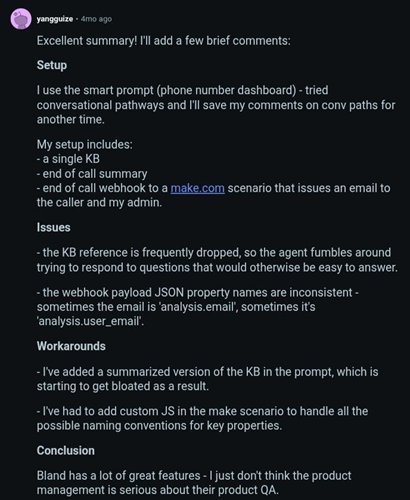
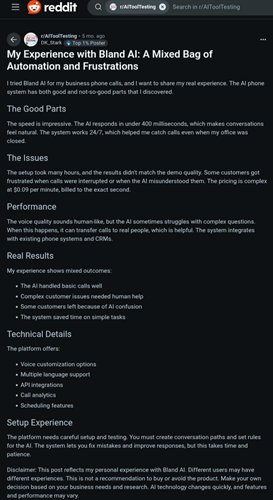

Conclusion
The underlying technology of Bland AI TTS offers compelling potential for a broad array of applications that demand highly realistic, emotionally intelligent, and customizable synthetic voices. The best alternative for Bland AI TTS remains Edimakor's TTS. It is a strong feature within a broader AI-powered video editing ecosystem. It's designed to be user-friendly for content creators, offering a good selection of realistic voices, multilingual support, and emotional styles, all integrated seamlessly into the video production workflow.
Leave a Comment
Create your review for HitPaw articles



